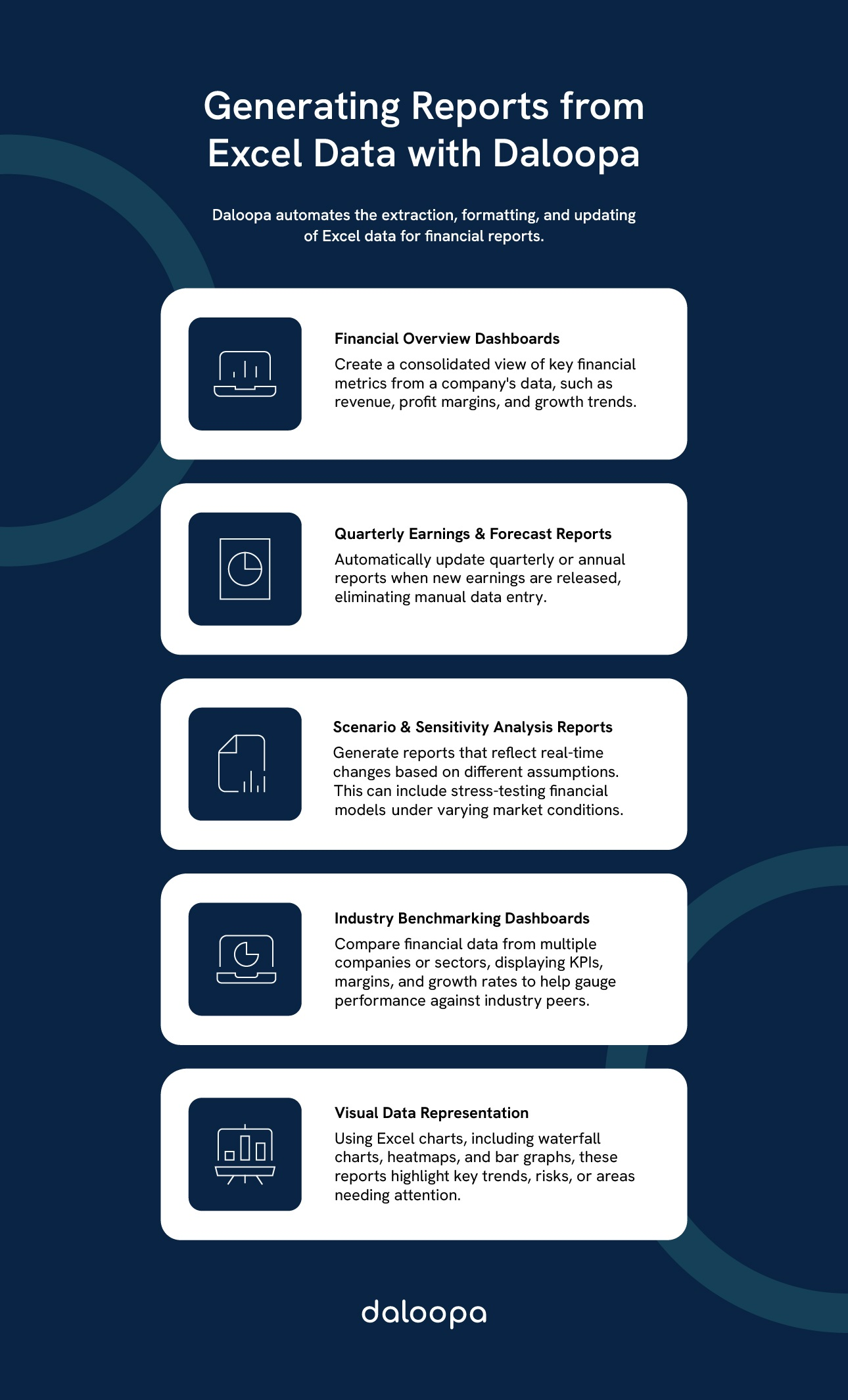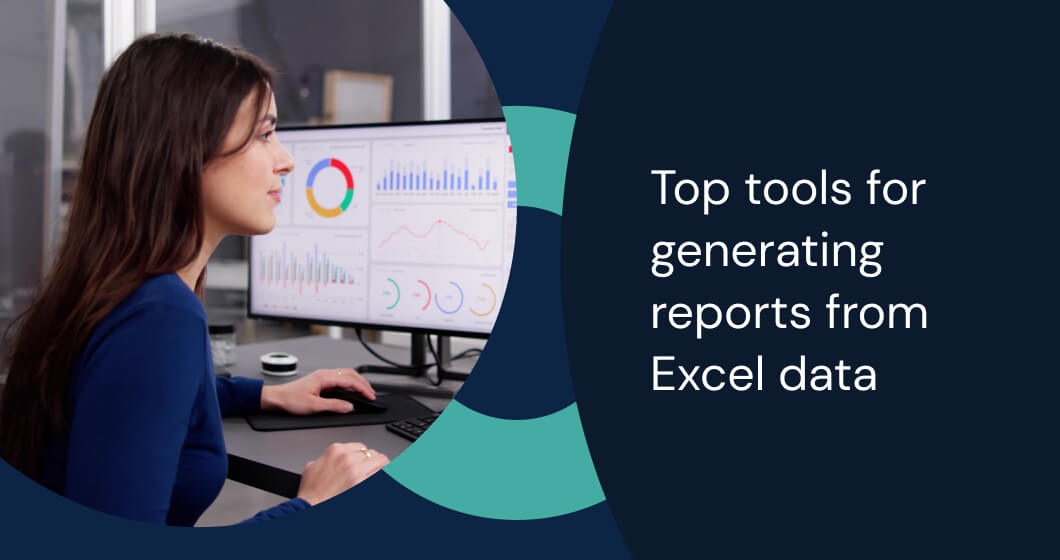Excel has long been a cornerstone for data analysis, and generating reports from Excel data has become even more efficient with the help of specialized tools.
These tools handle complex datasets, offer advanced visualization options, and promote collaboration. Below are some leading options, each with unique strengths to streamline reporting, improve accuracy, and enhance accessibility for businesses of varying sizes.

1. Daloopa: Complete, Accurate, and Fast
Daloopa leverages advanced artificial intelligence to simplify generating reports from Excel data. Its core strength lies in automating data extraction from complex documents like PDFs and scanned files, making it particularly valuable for financial analysts and investment professionals handling large datasets.
Automated Excel report customization tools reduce the manual work typically required in data entry, minimizing errors and ensuring precision in data processing. With Daloopa, organizations can achieve faster report generation while maintaining high standards for accuracy, allowing teams to allocate more time to meaningful analysis and decision-making.
Intelligent Data Extraction and Processing
Daloopa’s advanced AI-driven platform extracts precise financial data from complex document types, including PDFs, scanned documents, and even handwritten notes, allowing professionals to quickly gather relevant data without the need for manual input, reducing time spent on repetitive data-entry tasks. Financial analysts, in particular, benefit from Daloopa’s intelligent extraction, which eliminates common data-processing bottlenecks in high-volume environments.
Reliable Document and Financial Model Automation
Daloopa enables data extraction and supports automated updates to financial models, ensuring information stays current as new data becomes available. With automated workflows that can integrate into existing systems, Daloopa streamlines reporting, allowing analysts to focus on high-level analysis rather than routine updates.
Multi-Language and Global Data Support
With its ability to process documents in multiple languages, Daloopa makes it easier for multinational firms to manage data across borders. By accommodating different languages and currencies, Daloopa enhances accessibility and seamlessly allows teams to work with global datasets, enabling firms to centralize their data analysis and create a unified reporting framework for international operations.
Robust Data Accuracy Controls
Daloopa implements multiple layers of validation and accuracy checks to ensure data integrity when generating reports from Excel data. These controls include automatic cross-referencing, error detection, and anomaly notifications, which allow users to address discrepancies before reports are finalized. These built-in validation processes are crucial for sectors like finance, where precision in reporting directly impacts decision-making and compliance.
Advanced Security and Compliance Features
Daloopa’s platform prioritizes data security with features that include encryption, access controls, and regular security audits. For organizations handling confidential or proprietary data, Daloopa’s robust security protocols make it a trusted choice in high-stakes environments.
2. Power BI: Comprehensive Business Intelligence
Microsoft Power BI is a powerful tool for converting raw Excel data into interactive reports and dashboards, making it a popular choice for business intelligence. Seamlessly integrated within the Microsoft ecosystem, Power BI allows users to pull data from multiple sources, compile insights, and present them visually.
This compatibility, combined with advanced data modeling features, makes Power BI an effective solution for organizations that require real-time insights and interactive data visualizations for decision-making.
Unified Data Integration Across Platforms
Microsoft Power BI excels at integrating data from various sources, including Excel, databases, and cloud services, allowing organizations to consolidate data from different departments and systems into one cohesive view, streamlining the process of gathering, analyzing, and visualizing business intelligence. Power BI’s seamless integration with the Microsoft ecosystem enhances productivity, allowing users to leverage data stored across other Microsoft products effortlessly. Additionally, Power BI simplifies generating reports from Excel data, making it easier for users to create comprehensive reports directly from their existing Excel datasets.
Advanced-Data Transformation and Modeling
With its robust data transformation tools, Power BI enables users to clean, filter, and organize data for more effective analysis. Power Query, a key feature in Power BI, simplifies data preparation by allowing users to manipulate datasets without complex coding. Advanced data modeling capabilities let users define relationships, create custom metrics, and explore predictive analytics, empowering organizations to extract actionable insights from raw data.
Real-Time Analytics and Data Refresh
Power BI supports real-time data refresh and automatic updates, ensuring that dashboards and reports reflect the most current information. Users can monitor live data streams and quickly identify emerging trends or anomalies, making Power BI a powerful tool for dynamic, data-driven environments.
Interactive and Mobile-Optimized Dashboards
Designed with interactivity in mind, Power BI dashboards allow users to drill down into specific data points, apply filters, and visualize data from multiple angles. The mobile app extends this interactivity, enabling users to access, view, and adjust dashboards from smartphones or tablets.
Security and Compliance Management
Power BI includes robust security features such as data encryption, row-level security, and role-based access controls, making it suitable for organizations with strict data protection requirements. The platform’s compliance with various industry standards, such as GDPR and SOC 2, offers peace of mind to companies handling sensitive or regulated data. These security measures ensure that business intelligence is insightful and protected, allowing organizations to maintain high data integrity standards.
3. Google Data Studio: Collaboration and Integration
Google Data Studio is a cloud-based reporting tool focused on collaboration, particularly useful for teams that rely on Google’s suite of products. With real-time collaborative editing and seamless integration with tools like Google Sheets and Google Analytics, Data Studio enables teams to build, share, and refine reports effortlessly, making it a versatile choice for teams that need quick, collaborative reporting solutions that connect easily to popular data sources.
Collaborative Reporting and Real-Time Editing
Google Data Studio is designed for real-time collaboration, making it ideal for teams working together on reporting tasks. With live editing capabilities, team members can update and refine reports simultaneously, reducing miscommunication and ensuring everyone is working from the latest data, enhancing efficiency, especially for teams that require rapid updates and shared insights. Additionally, it simplifies generating reports from Excel data, streamlining the reporting process and enhancing data analysis efficiency.
Integration with Google and Third-Party Data Sources
Data Studio seamlessly integrates with Google products like Google Sheets, Google Analytics, and BigQuery, providing a centralized platform for reporting on data from multiple sources. Data Studio also supports integration with various third-party sources, enabling users to connect external data to their reports, allowing teams to consolidate information from diverse platforms, and presenting a unified view of performance metrics.
Customizable Dashboards for Targeted Reporting
Google Data Studio’s customizable dashboards allow users to tailor report views for specific audiences, such as executives, clients, or departments. Users can adjust layouts, apply filters, and add personalized elements to make data presentations more relevant to each stakeholder group. These customization features enhance reports’ clarity and impact, making highlighting key metrics or insights easy.
User-Friendly Interface with Accessible Learning Resources
Google Data Studio features a straightforward, drag-and-drop interface that requires minimal training, allowing users with varying technical skills to become proficient quickly. The platform’s accessible design is complemented by extensive tutorials and resources, helping users maximize the tool’s functionality.
Enhanced Data Visualization and Branding Options
Data Studio provides flexible design options, including personalized colors, fonts, and visualization styles, allowing users to align reports with brand guidelines or specific presentation needs. Users can display complex data clearly and engagingly with various data visualization formats, such as graphs, charts, and tables, making it an excellent tool for generating reports from Excel data.
4. Tableau: Advanced Visualizations and Big Data Handling
Tableau is a high-powered visualization tool known for its ability to handle large datasets and present data in engaging, story-driven formats. Ideal for companies requiring detailed data analysis and sophisticated visualization, Tableau allows users to turn complex datasets into interactive dashboards that communicate insights effectively, making it especially valuable for sectors that rely on data storytelling to inform strategic decisions and engage stakeholders.
High-Performance Big Data Integration and Analysis
Tableau is designed to handle vast datasets efficiently, making it an ideal choice for companies working with large-scale or complex data. The platform integrates seamlessly with numerous data sources, including cloud databases and data warehouses, allowing users to import, blend, and analyze massive datasets with minimal lag. This capability is particularly beneficial for finance, healthcare, and retail industries, where rapid data analysis is crucial for decision-making.
Sophisticated Data Storytelling with Interactive Dashboards
Tableau excels in creating interactive dashboards that allow users to dive deep into data insights and present information in a narrative format. With a wide range of visualization types, including maps, heatmaps, and tree maps, Tableau helps users convey complex data stories that resonate with diverse audiences. This storytelling approach makes it easy for stakeholders to interpret and engage with data, improving comprehension and driving informed decisions.
Advanced-Data Preparation and Cleaning Tools
Before visualizing, Tableau offers robust data cleaning and preparation tools, such as Tableau Prep, which enables users to filter, format, and organize data directly within the platform. These tools are invaluable for teams needing reliable, structured datasets for accurate analysis. Tableau’s data preparation capabilities simplify handling unstructured or incomplete data, ensuring final visualizations reflect a clear, organized dataset.
Accessible Yet Powerful Interface
Tableau’s visual-first design allows users to create complex visualizations through an accessible drag-and-drop interface. While beginners can easily generate basic reports, advanced users benefit from Tableau’s range of tools, including calculated fields, parameters, and filters. The platform also offers extensive resources, from tutorials to a supportive community.
Deep Customization for Personalized Reporting
Tableau allows users to tailor visualizations with extensive customization options, including adjusting layouts, color schemes, and data labels to match brand guidelines or specific presentation goals. Advanced users can customize using scripts and calculated fields, enabling highly specific insights and bespoke data analysis, ensuring that dashboards and reports can be uniquely adapted to the needs of each organization or audience.
5. Zoho Analytics: Affordable and Feature-Rich
Zoho Analytics provides a feature-rich reporting platform at an accessible price point, making it an excellent option for small to mid-sized businesses. It combines affordability with capabilities typically found in more expensive tools, such as AI-assisted reporting, pre-built templates, and real-time collaboration, allowing businesses to generate insightful reports without a steep investment, balancing cost and functionality effectively.
Cost-Effective Business Intelligence for Growing Teams
Zoho Analytics stands out as an affordable, comprehensive business intelligence tool ideal for small to mid-sized companies. With a subscription model designed for cost-conscious organizations, Zoho offers a competitive suite of analytics features without sacrificing quality. Businesses can access advanced reporting and insights typically found in pricier platforms, allowing them to stay data-driven without stretching their budget.
AI-Enhanced Reporting and Insight Generation
Zoho Analytics incorporates AI-powered Excel report customization tools like “Zia,” Zoho’s AI assistant, which simplifies report creation by guiding users through data exploration and generating automated insights. This feature is particularly valuable for teams that need quick, data-backed insights but may lack extensive data science resources. Zia’s assistance in interpreting patterns and trends also helps users make data-informed decisions with ease and confidence.
Ready-Made Templates and Dashboards for Fast Implementation
The platform provides a variety of pre-built templates and dashboards, allowing businesses to start generating insights immediately. These ready-made options are customizable, making it easy to tailor dashboards to specific metrics and objectives while minimizing setup time.
Real-Time Collaboration for Enhanced Team Productivity
Zoho Analytics supports real-time collaboration, enabling team members to edit, refine, and discuss reports in one shared environment. With shared access, Zoho Analytics is well-suited for businesses prioritizing collaborative decision-making and agile data sharing.
Flexible Customization and Integration Capabilities
Offering extensive customization options, Zoho Analytics allows users to create unique fields, formulas, and dashboards that cater to specific business needs. Zoho supports API integrations for added versatility, enabling seamless connection with third-party software like CRM and ERP systems.
Finding the Right Excel Report Customization Tool for Your Business
When choosing an Excel report customization tool, consider your organization’s needs and budget. Factors to weigh include:
- Customer support: Responsive service with comprehensive documentation and support channels
- Data security: Compliance with industry regulations to protect sensitive data
- Pricing: Plans that match your budget and feature requirements
- Integration: Compatibility with existing software and tools in use
- Scalability: Capacity to manage growing data volumes without loss of performance
- Collaboration: Strong support for team-based report creation and sharing
- Visualization: Advanced and customizable charting options for better presentations
- Financial Reporting Automation: Features that save time through scheduled report generation and automatic distribution
By evaluating these elements, you can select a reporting tool that aligns with your business goals and empowers your teams with better, data-driven decisions.
Maximizing Efficiency in Generating Reports from Excel Data
Generating reports from Excel data has never been easier with the wide array of specialized tools available today. Each tool offers unique features that enhance the accuracy, efficiency, and accessibility of your reports. By integrating these tools, businesses can turn complex data into clear, actionable insights while fostering better collaboration. Explore these options to streamline your reporting process and elevate your data analysis capabilities.
Daloopa offers real-time data integration, advanced visualization, collaborative tools, and powerful financial reporting automation features to save you time and ensure accurate, up-to-the-minute reports. By simplifying the process of generating reports from Excel data, Daloopa streamlines your workflow and empowers your team with reliable data insights. Learn more today or request a demo.



